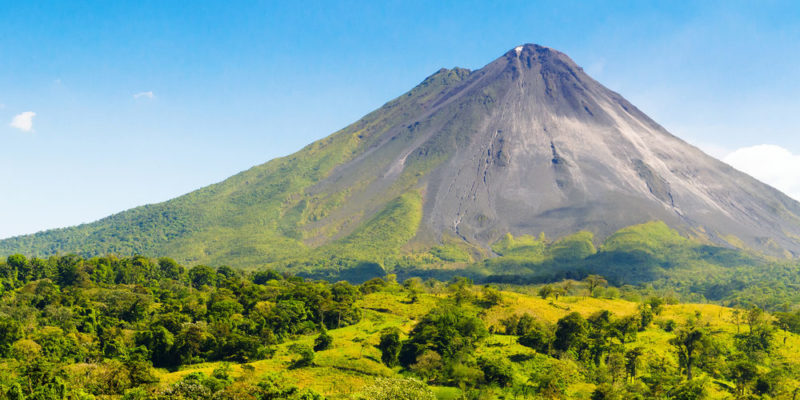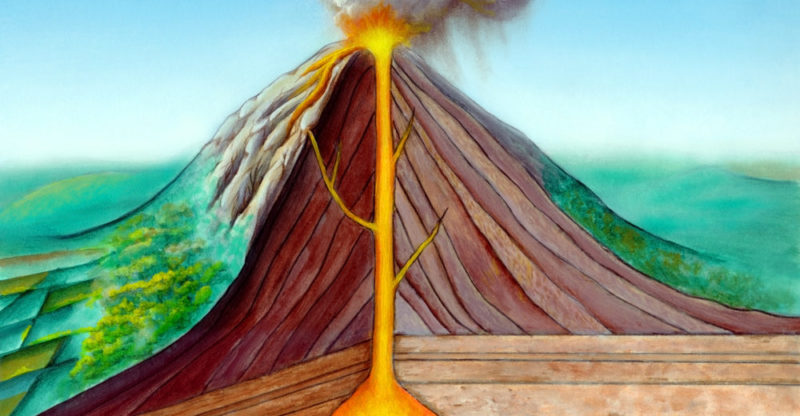We explain what a volcano is, its classification and the types of activities it presents. Also, its general characteristics and more.
What are volcanoes?
Volcanoes are openings in the earth's surface in the form of mountains, which have an upper crater through which different magmatic materials (in gaseous, liquid and solid states ) that come from the interior of the Earth can be expelled .A volcano is generated when magmatic materials, which reach a high temperature and high pressure, release that pressure after a movement occurs in the plates that make up the earth's crust. Magma flows through the cracks and has a lower temperature as it gets closer to the surface. This change in temperature generates the lava explosion.
Volcanoes are not always active. An active volcano is considered when it can expel magmatic materials on a regular basis . The type of volcanic eruption depends on the temperature, composition, viscosity and elements of the magma.
A dormant or dormant volcano is considered when the magma in the depths of the earth does not reach the sufficient temperature or pressure to generate the explosion towards the surface. The resumption of volcano activity can never be ruled out with total certainty, however, volcanoes that have not erupted in the last hundred years are considered extinct.
Characteristics of the volcanoes
 Among the main characteristics of volcanoes, the following stand out:
Among the main characteristics of volcanoes, the following stand out:
- They are mountains or hills in a conical shape that have a crater at the top.
- Their surface is covered with lava and ash from previous eruptions that, as they cool, harden and form igneous rocks that accumulate and accentuate the conical shape of the volcano.
- They can erupt lava , which is magma from the interior of the Earth that rises to the surface and can reach between 4 and 200 kilometers in height during the explosion.
- They have internal cracks through which magma flows which, depending on its composition, can reach temperatures between 700 and 1300 ºC.
- They are capable of accumulating a great pressure and temperature inside.
- They erupt when tectonic plates move and the volcano's internal pressure is released through the crater, causing the magma to explode.
Structure of volcanoes
 The structure of volcanoes is made up of:
The structure of volcanoes is made up of:
- Magmatic chamber. It is the deepest part under the earth's crust in which the molten lava that comes from the mantle accumulates , an even deeper layer of the earth . The accumulation of lava mixes with other materials, such as gases and water.
- Dome or ledge. It is formed by accumulations of lava that cannot reach the earth's surface, but which cool between the layers of underground rock.
- Chimney or duct. It is the channel that joins the magma chamber with the crater or external opening of the volcano, through which the erupting magma rises.
- Volcanic cone. It is formed by the accumulation of solidified lava on the surface of the volcano, from previous eruptions. Over time and with each eruption, the cone takes an increasingly pronounced shape.
- Fissures They are small cracks through which magma or gases are expelled towards the surface, with less intensity than the materials that erupt from the volcanic cone.
- Crater. It is the outer opening of the volcano located at the top, through which it expels the lava. The size of the crater can vary with each eruption, depending on the intensity and level of destruction of the explosion.
Types of eruptions
 The types of volcanic eruptions depend on the temperature, composition and viscosity of the magmatic elements. There are three general types of eruptions: magmatic, phreatic, and phreatomagmatic eruptions.
The types of volcanic eruptions depend on the temperature, composition and viscosity of the magmatic elements. There are three general types of eruptions: magmatic, phreatic, and phreatomagmatic eruptions.Magmatic eruptions are those that occur when magma rises to the surface . They are classified into six types:
- Hawaiian eruptions. They are eruptions that occur in the volcanoes of the Hawaii region, which is a volcanic archipelago that constitutes one of the states of the United States. They are characterized by being the calmest eruptions with intense lava explosions and low levels of gaseous components and ash.
- Strombolian eruptions. They are eruptions in which the lava is very fluid and gives off abundant and violent gases that can reach hundreds of meters away during the explosion. No ash is produced and the lava that runs along the surface of the volcano does not reach as long an extension as the Hawaiian eruptions.
- Vulcan eruptions. They are eruptions made up of a large amount of gases and, due to the little fluid lava that is pulverized by the gases, an intense presence of ash is generated. The conical shape of these volcanoes is very pronounced by the accumulation of solidified ash.
- Plinian eruptions. They are eruptions caused by gases and are more violent than Vulcan eruptions. They form fiery clouds that, when cooled, precipitate in the form of ashes and can reach a large size.
- Fighting eruptions. They are very explosive eruptions that emanate consistent lava accompanied by clouds made up of gases, water vapor and ash, and that are capable of destroying everything they cover.
- Fissure eruptions. They are eruptions that originate due to an extensive dislocation of the earth's crust, in which lava flows along the cleft. The lava from these eruptions, when cooling, can rise to the surface and form islands such as the Canary Islands ( Spain ) or the Cyclades Islands ( Greece ).
The phreatic eruptions are those that are produced by the rapid conversion of groundwater into steam and that interact with sources of magmatic heat. As a result, the eruptions are cooler and do not emanate lava.
Phreatomagmatic eruptions are those that are produced by the rapid cooling of magma that gives rise to pyroclastic fragments that are emanated through an eruption, without the presence of lava. Pyroclastic fragments can be: juvenile, lithic or crystals.
The above content published at Collaborative Research Group is for informational and educational purposes only and has been developed by referring reliable sources and recommendations from technology experts. We do not have any contact with official entities nor do we intend to replace the information that they emit.
Veronica is a culture reporter at Collaborative Research Group, where she writes about food, fitness, weird stuff on the internet, and, well, just about anything else. She has also covered technology news and has a penchant for smartphone stories. .
Leave a reply
Your email address will not be published. Required fields are marked *Recent post

Sport: What Is It, Types, Risks, Features, Characteristics and Examples

Dogs: Emergence, Features, Characteristics, Feeding and Breeds

Story: Definition, Elements, Structure, Features and Characteristics

